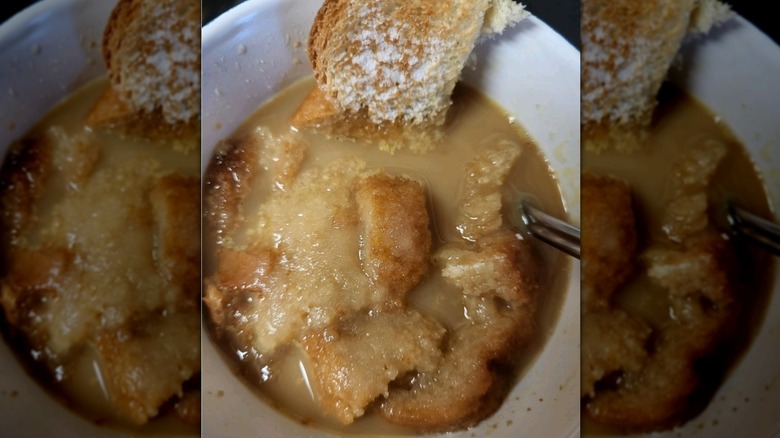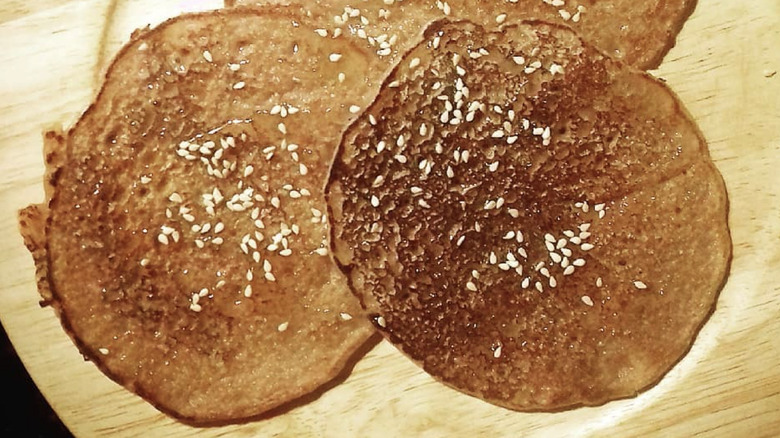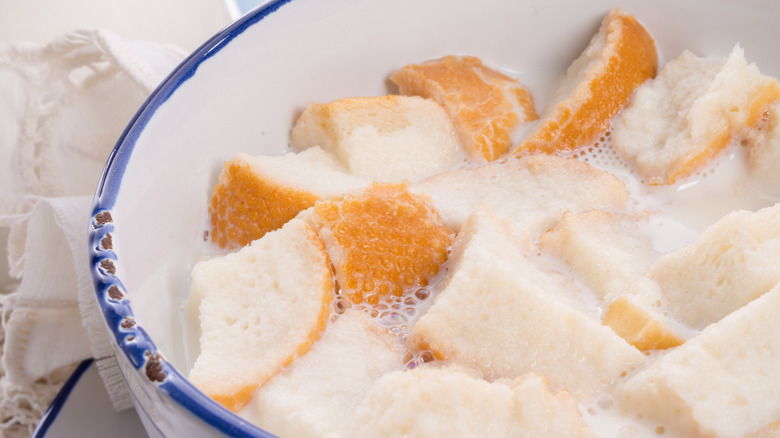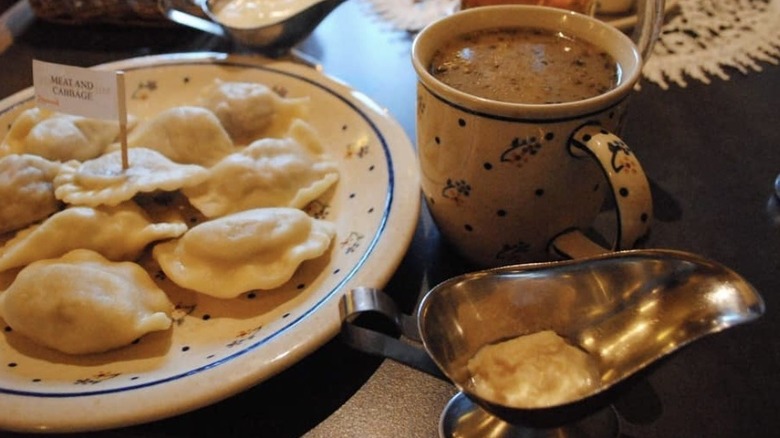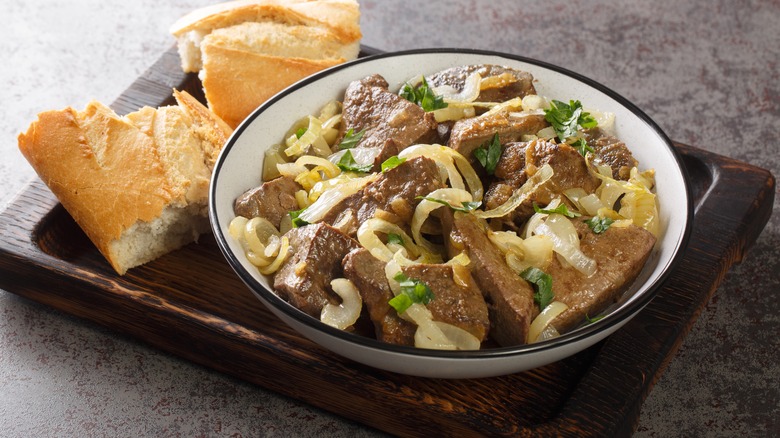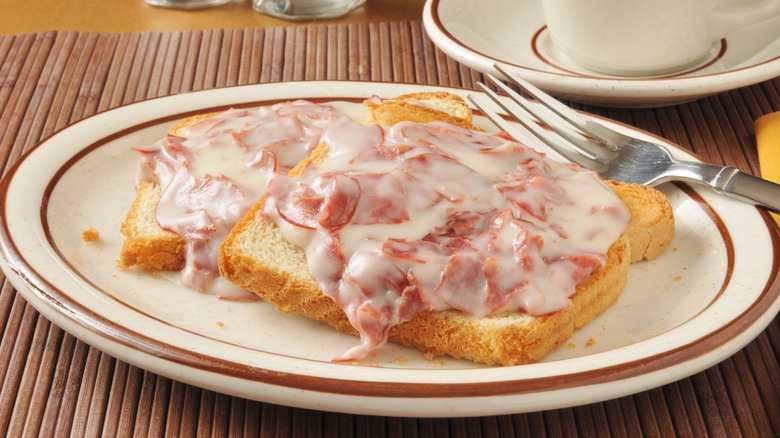Forgotten Breakfast Foods That No One Eats Anymore
Throughout history, breakfast has been considered a vital meal, readying everyone from royalty to the common folk to take on the day's work. Given this, it's interesting to ponder what these early people ate before the advent of conveniently boxed cereals and frozen waffles — a dreaded thought, indeed.
What did these old-fashioned morning meals look like, and why have they disappeared from the breakfast table? Many dishes vanished alongside shifting economies, evolving out of necessity in harsh times and trailing off as times improved. Others transformed, taking on new incarnations that render them nearly unrecognizable from their origins, as was the way with hasty pudding — a colonial breakfast dish that slowly evolved from a basic morning meal to a sweet dessert topped with cream.
A few of these foodstuffs have gone the way of the dodo, becoming near extinct at the breakfast table for entirely different reasons. From Depression-era dishes to pre-dawn meals eaten by the ancient Greeks, a whole host of breakfast foods have come and gone over the years, all but forgotten by a dedicated few. It's time to dig up these recipes of the past, examining these bygone breakfast foods with modern eyes.
Coffee soup
Coffee soup was a thrifty breakfast food born out of the Depression, made from coffee, bread, sugar, and milk, embellished with whatever additional ingredients were available. Sometimes, a pinch of fat might be added, or if resources were sufficient, a few spices, nuts, and dried fruit. Occasionally, crackers were used in place of bread, or cheese might be included, as well.
Favored because it could use less desirable ingredients like old coffee and stale bread, the dish also known as "wet toast" was associated by many with tough times, and likely faded as economic conditions improved in the following decades. Today, this fare is rarely served on breakfast tables except in Amish communities, where the dish continues to persist as a minimalist meal.
Yet, the Depression era wasn't the only time when coffee soup was popular in the past. Also known as zuppa di latte or caffelatte with stale bread in Italian homes, this warm breakfast soup stuck around for quite some time at tables where people loathed food-waste. Especially popular in the '50s and '60s in Italian communities, the soup was considered an ideal meal for the whole family, being consumed by everyone from children to grandparents. If the thought of small children drinking coffee for breakfast is concerning to you, worry not. Oftentimes orzo coffee was used in place of regular coffee for younger family members, as this barley-based version held no caffeine.
Teganites
It seems that even in ancient cultures breakfast was considered an important meal. In fact, one of our most cherished breakfast foods may be traced back more than 2,000 years, when an early form of the pancake, known as teganites or teganitai, was known to be eaten as early as 500 B.C.E.
A type of unleavened Greek pancake particularly popular during the 2nd century, teganites rarely graces the breakfast table these days in its original form. Made from water, flour, honey, and salt, this ancient breakfast food was cooked in oil over a smokeless fire using a frying pan known as a tagenon (hence the name teganites). Once plated, they were topped with more honey and occasionally a smattering of sesame seeds to give these hotcakes a savory character.
While this historic foodstuff may be a thing of the past for many, modern versions of the dish have cropped up under the name tiganites, which often include yeast to give the cakes a puffier texture, similar to that of a doughnut. An updated take on the original, they can be served with savory elements like mizithra cheese or feta, or complemented with fruit and nuts for a sweeter touch.
Milk toast
Composed of toasted bread broken apart and added to warm milk, the aptly named milk toast was once a widely eaten breakfast during the 19th century, with countless 1800s-era cookbooks holding recipes for this simple meal. Initially considered a food for those who were sick, the dish was admired as a food which was basic and easy to digest, especially for the elderly. Considered by many to be a precursor of cereal, milk toast was often eaten by little ones before convenience breakfasts like boxed cereal took over, praised as a breakfast essential that was both comforting and filling.
Although older milk toast recipes often included a bit of salt, later recipes came to include sweeter elements like cinnamon sugar. The simple dish was made by toasting and buttering bread, ripping it into smaller pieces, adding sweeteners or spices, and pouring hot milk over the bread. This frills-free breakfast item stuck around for centuries before petering out, stretching well into the 20th century as a cherished children's food often complemented with butter and sugar. Since then, other more flavorful incarnations of this dish have been seen in the South and Appalachian areas, such as cornbread and milk, or cornbread and buttermilk.
Beer soup
Beer for breakfast? Oddly enough, this filling fare was considered a breakfast fit for royalty in the medieval period. In the 1600s, this was the standard morning meal for Prince Friedrich Wilhelm, an early Prussian leader. Strange as it sounds, beer soup was a routine dish throughout central Europe during the medieval age and the early modern era, with many different versions being recorded. At its core, this boozy breakfast consisted of a combination of beer, fat, cream, flour, and egg yolk. Meanwhile, more extravagant recipes included onions and cheese or precious spices to make the dish more robust.
Recipes for beer soup survived in German culture, being brought to America along with German immigrants in the 19th century. Such recipes detail setting the egg yolk and flour in a bowl, while heating beer, water, sugar, and salt to pour over, and finally whisking the mixture together. Likewise, the Danes invented the similar beer bread porridge, known as øllebrød, around the 13th century.
Very similar to beer soup, øllebrød is a filling porridge composed of stale rye bread (which is actually different in Scandinavia) soaked in dark beer and warmed on low heat until pudding-like. A welcomed breakfast for working class people on cold mornings, the dish could be embellished by adding elements like cinnamon, cardamom, sugar, or syrup. Those who've tried this beer pudding today (as it's still eaten widely in Denmark) compare the dish to oatmeal, noting flavors of yeast and a natural wholesomeness, standing in many's eyes as a stark improvement on its more basic cousin.
Liver and onions
You may have heard of liver and onions, but have you heard of it for breakfast? As shocking as it may sound, many people once consumed this organ-heavy dish in the morning hours, serving it alongside other breakfast staples like bacon and eggs. Traditionally an English foodstuff, this former breakfast food was often made from liver slices which were fried or cooked with onions, becoming so common in the U.S. it was once regularly served in diners across the nation.
Many types of liver could be used in this meaty dish. In the United States, pork or beef liver was typically used, although lamb liver was more common in the U.K. Why the disappearance from the breakfast menu? Beef liver is known to come with a distinct smell and a bold flavor that some diners claim to be too strong. Moreover, many seem to have an ingrained distaste for offals, seemingly disregarding the protein entirely as an inferior cut of meat.
Others have shied away from the dish for health reasons, with sources recognizing an individual slice of liver to have as much as 90% of an adult's suggested daily cholesterol in it. Additionally, the dish requires a good deal of prep work, making it an unappealing meal to cook first thing in the morning. In order to remove the bitter flavor of the organ, recipes recommend soaking the liver in milk for an hour or two, helping to temper its intense taste. Although no longer seen on the mainstream breakfast table, liver and onions can still be found in Latin American cuisine, where it is frequently served alongside rice and tortillas.
Chipped beef on toast
Known by far less flattering names that you can search up if you dare, chipped beef (also called creamed chipped beef) on toast was one of the most common breakfast dishes served during the 1940s, with American soldiers crafting up many cheeky names for the fare during WWII. Composed of thinly-sliced beef drenched in a cream sauce (made from flour, butter, and milk) and stacked atop toast, this breakfast food was known to be both filling and frugal. While the recipe dates back at least 100 years in Army cookbooks, the meal dates back to the turn of the 19th century before being adopted by the military as a breakfast food.
Using chipped beef as its main ingredient — an item which was salted, dried, and compressed into a shelf-stable foodstuff — the ingredients were easily transportable and high in protein, making it an excellent dish for hungry soldiers, albeit one quite high in sodium. However, as the 1940s came to a close and wartime rationing fell away, the dish's popularity dipped.
Yet the recipe did not disappear entirely, with chipped beef on toast remaining a favored menu item in Pennsylvania and the Philadelphia regional area, known by some Pennsylvania Dutch as Dutch frizzled beef. For the rest of us, most prefer something a little more akin to biscuits and sausage gravy in the morning hours, leaving creamed beef and toasted bread a dish perhaps best left in the past.


